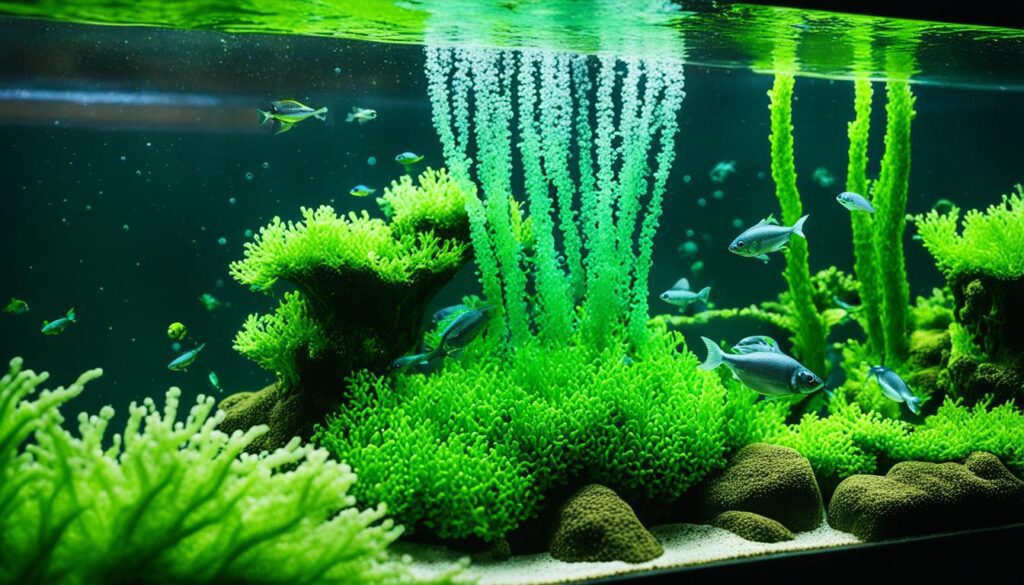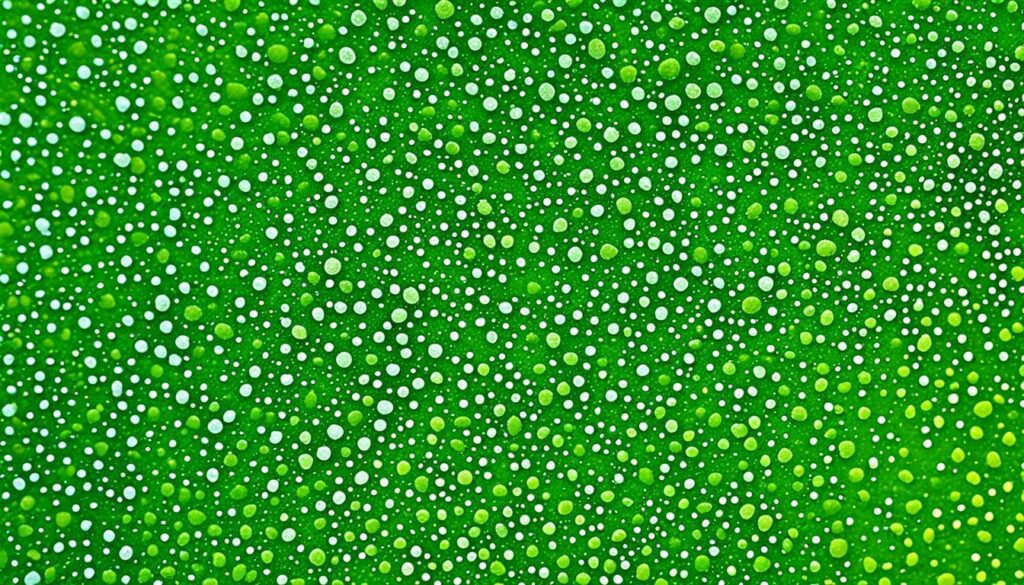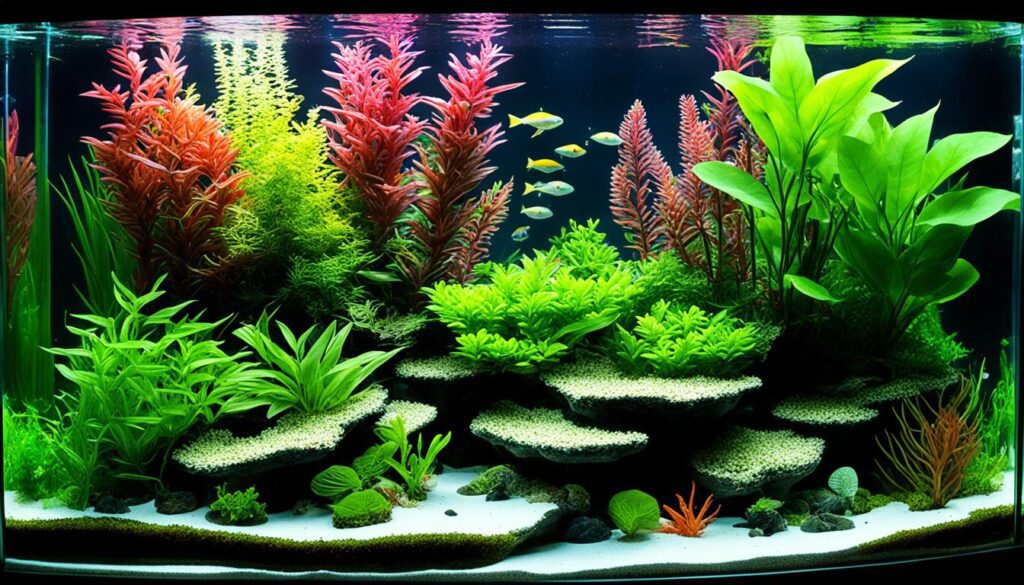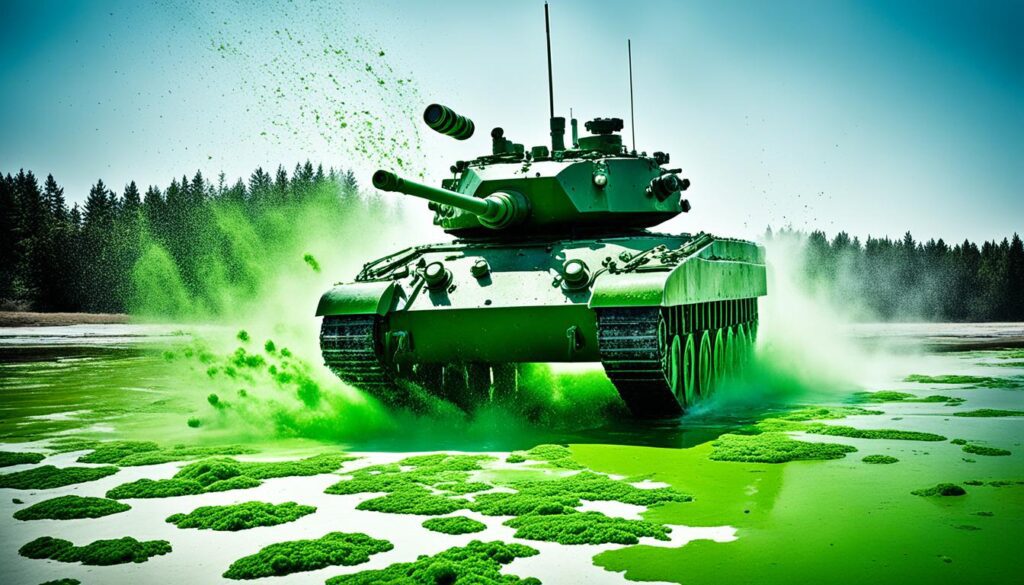We’ve all seen those unwanted green spots on our aquarium walls. They’re known as green spot algae, a common issue for many. Before grabbing scrubbers and chemicals, it’s vital to understand the real problem. It’s about the imbalance in our aquarium ecosystem balance. To control green spot algae, we need to focus on maintaining a healthy ecosystem.
I’ve spent a lot of time creating beautiful underwater worlds. One key learning is that preventing algae blooms starts well before green spot algae appears. It comes down to nutrient imbalances and too much light. To beat green spot algae, we need to balance our light, check our water, and feed our fish correctly.
I want to share what I’ve learned about aquarium algae prevention. Getting rid of algae isn’t about using force. It’s more about skill and careful management. By keeping our aquarium balanced and respecting our water, we can have clear, healthy tanks.
Understanding Algae Blooms in Your Aquarium Ecosystem

Keeping your aquarium healthy needs good knowledge about various factors. Algae blooms are common and happen due to nutrient, light, and ammonia imbalances. These blooms affect the water’s health and look.
Common Misconceptions About Algae
There are myths about algae we should clear up. Some think algae only grows in high-nutrient water. But, it can also grow with low nutrients if light and ammonia aren’t right. Also, quality fertilizers don’t cause algae directly. They might just show existing problems.
Identifying the Signs of an Algae Bloom
An algae bloom changes how your aquarium looks and feels. Spotting this early is key. Look out for murky water, and sudden green or brown films. These signs can mean there’s too much light or organic waste.
Light plays a big part in algae growth. Even well-maintained tanks can have algae if the light’s too strong. Keeping nutrients balanced with regular water changes helps stop algae.
A good setup for a planted aquarium needs a filter and powerhead. This makes sure water moves well and plants stay healthy. It also stops algae from growing in still water.
- Doing a 50% water change weekly reduces ammonia and nitrites.
- Cleaning the substrate and filter helps remove too much organic matter.
- It’s important to know how light and nutrients affect algae growth.
With the right care and understanding, you can manage algae better. This makes your aquarium healthier and more beautiful to look at.
Encountering Green Spot Algae: Characteristics and Challenges

When you have an aquarium, you’ll likely face green spot algae (GSA) at some point. It’s not just an eyesore; it points to problems in your tank’s balance. By knowing more about GSA, its removal challenges, and its toughness, you can keep your tank healthier.
Defining Green Spot Algae
Green Spot Algae shows up as small, green circles. You’ll see it on your tank’s surfaces and on plants that don’t grow fast. It loves strong lights and comes around when there’s not enough phosphate and CO2. GSA sticks hard to places, making it tough to clean off. This is a big headache for people with tanks.
Why Green Spot Algae is Resilient to Common Removal Methods
GSA is tough because it’s got a strong build and grips surfaces tightly. Even a lot of scrubbing or changing how you clean might not beat it. Knowing why GSA sticks so well could help you find better ways to get rid of it.
To fight this sturdy algae, you need a plan that does more than just clean it up. You must also fix what’s causing it. Changing water often and keeping nutrients like phosphates in check are key. Let’s look at how different things in your tank affect algae:
Condition |
Impact on Algae Growth |
|---|---|
Strong lighting without CO2 supplementation |
Makes GSA grow fast |
Low phosphate levels |
Makes GSA show up |
High nutrient levels |
Helps various algaes grow, but you can stop GSA by controlling it |
Insufficient water changes |
Causes too many nutrients, helping algae thrive |
In the end, while some fish and chemicals can slow GSA down, they might not end the problem. Really understanding green spot algae characteristics and tackling the issue from all angles works best. GSA may be tough, but with smart actions, you can be tougher.
Finding the Balance: Lighting vs. Nutrients in Algae Growth

As an aquarium lover, I’ve learned that controlling algae is about two things. It’s about the right balance of aquarium lighting balance and nutrient optimization for algae control. To stop algae from growing too much, you need the right amount of light and nutrients.
How Over-illumination Can Encourage Algae
Too much light often leads to too much algae. Most aquarium kits have lights that aren’t bright enough. But using lights that are too bright isn’t good either. It’s best to start with lights turned down to 20-40% brightness for tanks with plants. Slowly increase the light up to 8-12 hours a day. This helps plants grow but doesn’t help algae too much.
If algae starts to grow, cutting down on light can help you get back in control.
Adjusting Nutrition to Thwart Algae
Getting the right nutrient balance is key to fighting algae. While plants and algae fight over nutrients, adding more fertilizer won’t fix the problem. It’s all about having enough nutrients for the plants without feeding the algae. Adding the right amount of nutrients helps plants stay healthy and beat out the algae. But, you have to be consistent. Changes in nutrient levels can make algae problems worse.
To use these ideas in your tank, look at your lighting and nutrient plans. If your tank is new or extra light is making algae worse, changes might be needed. This can lead to clearer water and healthier plants. Watch your water closely. Make changes as you need. Light and nutrients affect how well algae can grow and do photosynthesis.
Keeping algae out while helping plants grow is a careful balance. It takes patience and small changes over time. By getting the balance of light and nutrients right, your aquarium can be a lively, healthy world.
Green Spot Algae Control: Targeted Tactics for a Clear Aquarium

For aquarists, finding green spot algae (GSA) can be troubling. These bright green spots stick to glass and leaves, making your tank look unclear. Yet, with the right strategies, battling GSA is easier than you think. This keeps your tank looking great.
Start with light and nutrient control to fight GSA. Too much light and nutrients, especially phosphates, welcome algae. Keep your water fresh and nutrients balanced. Keeping phosphate levels between 1-3ppm helps. This also supports your plants’ health.
Removing GSA physically is another option. Use a razor or scraper for glass tanks to get rid of algae. Spot treating with hydrogen peroxide can also kill algae without harming the tank.
Preventing GSA is key. Regularly check and manage phosphate levels, and feed your fish the right amount. Use special liquid fertilizers for your plants. This keeps your tank healthy and algae-free.
Tactic |
Description |
Frequency |
|---|---|---|
Light Adjustment |
Reduce lighting hours to prevent algae growth |
Daily monitoring |
Phosphate Management |
Maintain levels within 1-3ppm |
Check weekly |
Physical Removal |
Use tools like algae scrapers for immediate removal |
As needed |
Spot Treatment |
Apply hydrogen peroxide directly to affected areas |
Every 2 weeks or as spots appear |
Nutrient Balance |
Use formulated liquid fertilizers to supplement plants |
During routine water changes |
Understanding and acting on GSA causes helps keep your tank clear. Using these strategies, we not only fight GSA, but we also boost our aquariums’ overall look and health.
Integrating Algae Eaters into Your Tank’s Environment

Adding Amano shrimp and Nerite snails to your aquarium is a smart way to fight green spot algae. These critters not only keep the water clean but also improve the tank’s ecosystem.
The Role of Amano Shrimp in Algae Management
Amano shrimp are known for their hunger for algae, making them a big help in keeping the tank clean. They eat algae and reduce the need for you to clean as much. Plus, they help with the tank’s nutrient cycle. To discover more about keeping your aquarium in balance, check how live plants help fight algae.
Nerite Snails: A Slow yet Steady Solution
Nerite snails, though slower than shrimp, are just as good at eating algae. Their slow, steady eating helps manage spot algae well. They keep glass and decorations clean, making sure your tank looks great.
Using both Amano shrimp and Nerite snails helps keep your tank free of algae. But, it’s vital to ensure your aquarium’s conditions are right for these algae eaters.
The success of these natural solutions also relies on good tank management. Watching water quality, providing the right light, and feeding correctly are key. Following expert tips on tank care and algae prevention is crucial.
Adding Amano shrimp and Nerite snails is a great natural method to improve your aquarium. It helps keep your tank beautiful and maintains a healthy, algae-free ecosystem.
Top Tools and Techniques to Combat Green Spot Algae
In my journey as an aquarium fan, I’ve learned how crucial balance is. Green spot algae (GSA) can really mess with your tank’s vibe. It usually shows up when things aren’t quite right with phosphate and organic levels. Then, you get those ugly green spots on the glass.
Algae Scraper: Your First Line of Defense
The moment I see those tiny green dots, I grab my algae scraper. It’s amazing at getting rid of those spots on the glass. With just a little effort, my tank looks clear again. This way, I don’t have to take drastic steps that might harm my tank’s environment. But sometimes, the scraper alone can’t handle it all, especially if the algae covers a lot.
It affects how plants grow too. The slow growers suffer while the fast ones thrive.
Chemical Interventions: Potential Risks and Rewards
Chemicals can act fast against algae, which sometimes feels necessary. Like using hydrogen peroxide, but carefully—no more than 4 ml per gallon. To fight other algae types, like blue-green algae, we might need to tweak nutrients and light. Plus, sometimes, we add chemicals. Finding the right mix of nutrients and light, according to the Redfield ratio, is key against green spot algae.
Using these strategies, I made my aquarium a peaceful place. Regular care like weekly water changes and keeping the filter clean helps a lot. This way, I keep algae under control and make a great home for my fish. Stopping algae before it starts and acting fast when it appears keeps my tank healthy.








